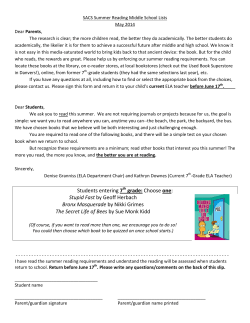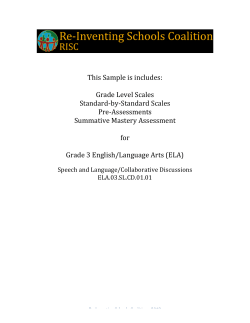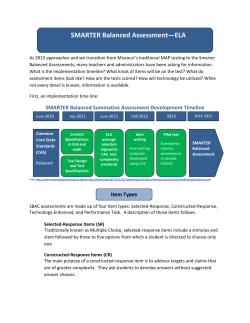
Document 247309
Why was Pluto Demoted? This presentation and related materials can be found at http://aaslclusters.weebly.com/ http://www.wombania.com/pluto.htm Why was Pluto Demoted? Libraries and Stronger Student Test Scores through Better Questioning Skills by y Marc Aronson & Dorcas Hand Big Picture: Bad 31.1% 31 1% of grade 3-8 students across New York State met or exceeded the ELA proficiency standard; 31% mett or exceeded d d the th math th proficiency fi i standard t d d - IN OTHER WORDS, 69% DID NOT The ELA proficiency results for race/ethnicity groups across grades 3-8 reveal the persistence of the achievement gap: only 16.1% of African-American students and 17.7% of Hispanic students st dents met or exceeded e ceeded the proficiency proficienc standard IN OTHER WORDS 80 80+% % DID NOT Worse 3.2% of English Language Learners (ELLs) in grades 3-8 met or exceeded the ELA p proficiency y standard; 9.8% of ELLs met or exceeded the math proficiency % DID NOT standard 90+% 5% of students with disabilities met or exceeded the ELA proficiency standard; 7% of students with disabilities met or exceeded the math proficiency standard 90 % DID NOT 90+% Scary: 5 Largest Cities 80 to 90+% Failure Buffalo Yonkers New York New York City Rochester Syracuse Met or exceeded the Met or exceeded the ELA Proficiency Standard 11 5% 11.5% 16.4% 26.4% 5.4% 8.7% Met or exceeded the Met or exceeded the FAILED Math Proficiency Standard One or both 9 6% 9.6% +/‐ 90% +/ 14.5% +/‐ 85% 29.6% +/‐ / 78% 5% 6.9% +/‐ 95% +/‐ 92% Splintering “In 2012, there was a 12-point black/white achievement gap between average third grade English Language Arts scores, and a 14-point gap in eighth grade ELA scores. This year, the respective gaps grew to 19 and 25 points. In 2012, there was an 8-point gap between black/white third-grade math scores and a 13-point gap b t between eighth-grade i hth d math th scores. The Th respective ti gaps are now 14 and 18 points.” Carol Burris, Op-Ed in WP t 8/26/13 WPost, $ Makes a Difference CC Shows What We All Know Family F il W Wealth lth Family Resources Family a y Education duca o Family Culture What can we do to improve achievement h e e e and d minimize ze the disparities? p ELA/Literacy: 3 shifts 1 Building knowledge through content-rich 1. content rich nonfiction. 2. Reading, writing, and speaking grounded in evidence from text, text both literary and informational. informational 3. Regular practice with complex text and its academic language. Why? The CC Challenge For Students Is The Same as it is For Us http://www.independenceeventscenter.com/community-ice/Youth-Hockey Changing on the Fly They/We need to evaluate information, i f i fform jjudgments, g and come to conclusions when The answer(s) are not known and The answer(s) are in contention. Juxtapose and Think Margaret Bourke-White, http://tinyurl.com/n4d8k4s How Does “Information” Apply to the 3 CC Shifts? 1)Knowledge – Content Rich Connections from text to text – Citation as Treasure Hunt 2) Evidence from text Details, Details, evidence, argument – Compare and Contrast 3) Complex Text; Academic Language Ladder of resources – No Ledge Are You Starting to See Yourself in the CC Challenge? You should. http://tinyurl com/mg2x6f7 http://tinyurl.com/mg2x6f7 You Know (Or Can Know) How H M Materials t i l Connect C t How How to Select Materials that Allow Comparison How to offer students a Complex ladder of resources First a Little Test Name O One author, th text, t t or passage that th t you think thi k requires, and rewards, rereading for the age/ grade you serve? And then there is Shakespeare http://tinyurl.com/348tbcs http://tinyurl.com/5rnxu6 Now Name one NF author, th text, t t or passage - nott from a primary source - that you know requires, and rewards, rereading for the age/ grade you serve? http://commons.wikimedia.org/wiki/File:Question_mark_alternate.svg Hitherto http://www.flickr.com/photos/lesterpubliclibrary/5100412049/ In Other Words We W compensate t ffor fear f that th t NF is i difficult diffi lt or d dullll by stressing that it is quick, fast, fun. Thus, we steer away from NF that is Difficult, Diffi lt rich, i h complex, l has layers of meaning, rewards thought. How??? How can we prepare students for close reading di and d rereading di when h our entire ti focus is on p proving g that NF does not require that effort? What guidance can we give teachers when we never seek out NF that requires and rewards rereading? We Need To Train Our Eyes To break down NF Learn to find NF that rewards rereading Learn L how h to t juxtapose j t NF sources Learn Learn to find NF passages that inspire questions and lead to deep understanding. We W need d to t provide id teachers t h and d students t d t opportunities for the kinds of reading CC requires. What Worked in NYC? Lab Middle – An Example New York City Deputy Mayor Wolfson Visits Lab Middle; Congratulates g Students, Teachers and Administration Lab is one of 22 NYC schools ranked in the top 25 statewide as measured by the new more rigorous statewide, common core exams Lab L b teachers t h spentt ttwo years d developing l i CC Curriculum C i l – full knowledge and ownership Lab Principal let teachers lead y across all reading, g, all Lab librarians offered CC truly classes For students… students Astonishing 40% of Lab Middle Students who scored d 3 on last l t assessments t moved d to 4 on CC Test captured p the way y they y already y read Key Term: “Argumentative Text” Across all classes, students compare, contrast, evaluate juxtapose evaluate, juxtapose. Actively make meaning Not passively identify and define Knowledge In Formation That Th t is i what h t Information I f ti MUST mean Exercise Exercise Mental Muscle Making shape: taking possession of the i f information, ti understanding d t di it it, rephrasing h i it This This must characterize the whole school – and you are the key to creating that atmosphere Are You Promoting Argumentative Text? Text connections: fiction to NF; math to history; ELA to science? Is the library filled with displays featuring contention and debate? Are you updating the school on great NF that supports CC? Second Example: IS 52 Inwood I d – 60% ELL (97% Dominican) D i i ) 15% Special Needs Test scores down BUT Dr. Sal Fernandez: 2013 Elizabeth Rohatyn Prize Dr from Teaching Matters for supporting teachers and d learning l i Focused Focused on improvement in different cohorts, cohorts largest growth in weakest students Biggest Impact Most significant vector in your school score may be the performance of your weakest students You can have greatest impact by helping those struggling students Help them read for: Main point; subsidiary point; evidence, id argument, t POV Pick Pick two accounts of last night’s night s big game, one from city (state) that won, one from parallel that lost Compare – same event, lost. event just happened, happened what details does each use? How is game d described? ib d? CCC for CC Communicate often Collaborate widely Consistent message Everyone in building learning together Grant to Build Library at Inwood (IS52) Dynamic librarian seeded the idea A team weeded d d library lib off old/weak/damaged ld/ k/d d books leaving g many empty shelves Principal sees key need – find librarian to fill shelves (and workstations) with materials that will help students He understands the librarian is the next key member of his team Two Schools, Two Stories In one, scores up p – lessons In one, scores down – lessons Don’t mourn, organize And Make Friends Considering Clusters - Then • • • • Traditional Library display content St i htf Straightforward d Unbiased Just the facts Thanks to Sue Bartle, from a Workshop with Marc Aronson in 2013. Why was Pluto Demoted? Returning to our session title, wouldn’t this be a fun cluster? Beginning to change Here we have an open question – How did brothers manage? By juxtaposing these materials, viewers see questions rather than answers. answers Clusters that look ahead with more complicated questions. Questions rather than answers • Possible Assignment: Consider the Civil War from the perspective of a person or group who were there, but whose voice you have not heard often (blacks, women, immigrant, …) • How can students & teachers contribute to this cluster, to inspire further questions? • Can a stand-alone library display be a catalyst for the move to questions from answers? What questions come to mind just from this small array of books? • What questions come to mind just from this small array of books? • Is there any “right” answer, or even only one question? Life in the Civil War - How might your life be affected if it happened now, here, to you? Real people, real wars. Bosnia 1991 1993 1991-1993 Lebanon c. 1991 Two perspectives on the same events Split personality??? Perspectives p on Lincoln – in print and online Lincoln's American Dream: Clashing Political Perspectives, edited by Kenneth L. Deutsch and J Joseph hR R. F Fornieri i i (Vol.28, Iss.2, Summer 2007) “Lincoln, Hollywood, and an Opportunity for Historians” by James Grossman. The Journal of the American History Association (November 2012) Insights from assassinations PBS American Experience What do these men have in common? What can you learn from their differing experiences with similar challenges? Besides being president, all of these men sent Americans to _______. How do Libraries communicate? Traditional Signage & Book displays Reading lists, Pathfinders Classroom visits & hallway chats Newsletters home & PTA presentations Digital Di it l Websites Online catalog home page & searchability LibGuides, LibGuides Pinterest, Pinterest etc Electronic newsletters, QR code signage, links in books to author websites…. websites Referring back to Marc Students/adults need to adapt on the fly They/We y need to evaluate information, form judgments, and come to conclusions when The answer(s) are not known and The answer(s) ( ) are in contention. Supporting Student Achievement through Library Displays Offer Off different diff t perspectives ti Provide unexpected juxtapositions Knowledge, o edge, Evidence, de ce, Complexity Co p e y Inspire questions that support active learning Actively make meaning Activity: y You have 15 minutes to develop p a Cluster for Monday. Work W k alone l or with ith a partner. t Develop Develop an idea and/or find specific resources on your catalog or the web. Be B prepared d to t report: t Age Age group, topic 1-2 key questions that focus your cluster. What do you want your students to consider when they look at this cluster? What format do you want to use? (book display, pathfinder, Pinterest, …) [OPTIONAL] REPORTS Post P t your reportt to t http://aaslclusters.weebly.com/blog.html so that everyone can see. Key Outreach To T Parents P t – via i school, h l iin conjunction j ti with ith public bli library Parents, teachers, admins, must see you for who you are – for the knowledge you have In Particular “I didn’t realize schools could go without a library.” Houston Chronicle, Chronicle Nov. Nov 2013. 2013 http://tinyurl.com/nxajlyq http://tinyurl com/nxajlyq Where books are acquired: 7 to 12 Public Library 36% 31% Amazon.com 23% 13% Barnes a es & Noble ob e bookstore boo s o e 28% 16% 15% 16% School Library 13% 14% Scholastic book clubs WalMart or Sam's Sam s Club 18% 11% 7% Scholastic book fairs 9% 6% 5% Garage sale/sidewalk sale/secondhand shop U d bookstore Used b kt 4% 5% Other big box store (Target, Costco, etc.) 5% 2% Half-Price Books Fall 12 Spring 13 8% 4% Books-a-Million bookstore 2% 3% ebook apps 3% 3% 2% 3% Other online retailer (B&N.com, etc.) Independent / local bookstore (not a major national or… 0% 3% 3% 5% 10% 58 15% 20% 25% 30% 35% 40% 4-Wave trend of recommendations (0 to 6) 40% 38% 35% 30% 19% 20% 15% 10% 26% 24% 25% 13% % 12% 8% 8% 14% 29% 19% 17% 14% 27% 15% 9% 5% 0% Public Librarian Parenting Magazine Teacher Fall 2011 On-line research Spring 2012 59 School Book Fairs/Clubs* Fall 2012 Bookstore - browsing the shelf Spring 2013 Friend/family I make my own decision with no other th input i t Key y Point Library Lib & tteacher h iinfluence fl d down People making more decisions on own 60 T Types off Books B k P Purchased h d ffor Kids Kid (0 - 6) 65% 66% Picture Story book Coloring Book 55% Activity Book 42% 59% 45% 35% 35% Beginning/Early Reader 27% 28% Workbook 23% 21% Sound Book 17% Leveled Reader 17% Interactive 21% Girl 20% Boy 16% 16% Bible/Prayer Books 14% 15% Novelty book 11% Non Fiction Book Non-Fiction 15% 13% 13% Series/Chapter Book 3% Reference Book 3% Graphic Novel 0% 7% 5% 10% 20% 30% 61 40% 50% 60% 70% T Types off Books B k P Purchased h d ffor Kids Kid (7 - 12) Series Chapter Book 66% 33% Non-Fiction Book 72% 36% 33% 34% Leveled Reader Activity Book 31% 17% Picture/Story Book 36% GIRL (487) 20% BOY (519) 12% 12% Bible/Prayer Books 9% Graphic Novel 13% 9% 11% Reference Book 7% Interactive book 0% 10% 10% 20% 30% 40% 62 50% 60% 70% 80% What were important factors in getting book (0 to 6)??? For girls…… girls For boys……. boys Girls 0 to 6 Topic, story,… Your child likes… 40% 41% 34% It was a good price 40% 43% The title or cover… 34% 21% Major factor Critical factor There was "buzz"… 16%4% Topic, story,… 41% Y Your child hild likes lik … 39% It was a good price 40% The title or cover… 10% You liked the size,… 23% 7% Boys 0 to 6 35% Celebrity author 8% 2% I just needed to…8%7% 100% 63 Major factor 25% 10% 0% Critical factor There was "buzz"… 18%5% Celebrity author 12%7% 50% 39% You liked the size,… 23% 8% I just needed to…9% 2% 0% 46% 0% 50% 100% What were important factors in getting book (7 to 12) For girls…… Topic, story, subject or story interested your child 45% Your child likes the character or series 43% 38% It was a good price 41% 44% The title or cover caught g your attention 33% You liked the size, packaging, binding Th There was "buzz" "b " around d this thi book For boys……. Girls 7 to 12 Topic, story, subject or story interested your child 38% Your child likes the character or series 35% It was a good price 20% 7% 36% You liked the size, packaging, binding Critical Th There was "buzz" "b " around d this thi f factor book 15% 3% I just needed to pick something 8%2% fast 48% 43% 41% Major g your factor The title or cover caught attention 19% 5% 21% 23% Major factor 10% 8% Critical f t factor 18% 5% Celebrity author 10%4% I just needed to pick 8%4% something fast Celebrity author 7%1% 0% Boys 7 - 12 50% 100% 0% 64 50% 100% Why You Are Needed Parents buying more NF, especially for boys, BUT they y don’t think of y you as key y resource to help p in making selection. Buying based on topic and celebrity author – not thinking Put P t yourself lf fforward d – in i schools, h l tto PTA, PTA show h knowledge of NF, show best in NF, show pleasure l in i NF – establish t bli h your primacy i as resource Big Finish CC CC stark t k evidence id off splits lit p on school-wide focus on 3 CC success depends Shifts (CCC) Argumentative Text Debate everywhere Text connections everywhere You You are the hub of Informationx3 (CCC) Parent Outreach – establish authority Must develop tech/career track with CC thinking You As Apostle of 3C Communicate Collaborate C ll b t Consistent C it t CCC for CC Communicate often Collaborate widely Consistent message Outcome At At worst, better school At best, better school Why Was Pluto Demoted? This presentation and related materials can be found at http://aaslclusters.weebly.com/. Dorcas Hand Dr. Marc Aronson Rutgers University (NJ) bookmarch@aol.com www.marcaronson.com Director of Libraries (PS-8) Annunciation Orthodox School Houston, TX handd51@tekkmail.com www.strongschoollibraries.com www.studentsneedlibrariesinHISD.org Coming February 7 -- Rutgers g University y hosts first jjoint All-Day y Common Core event for Principals, Teachers, Librarians
© Copyright 2025





















